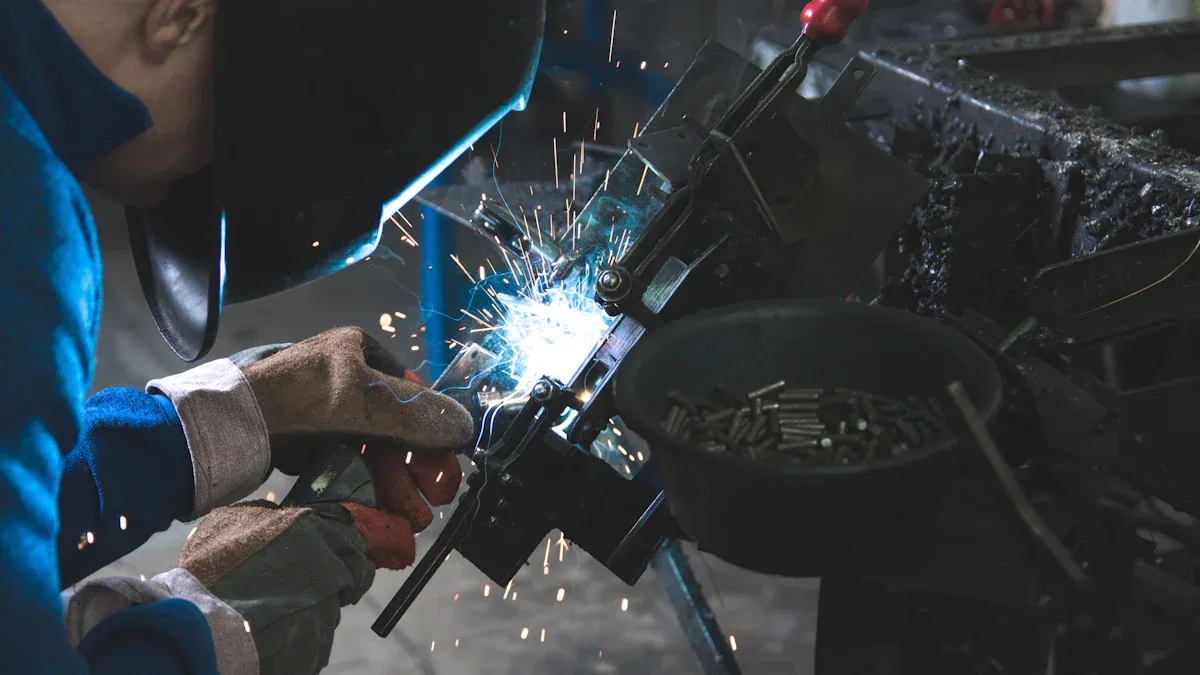A Quality Control Manual is like a guide for success. It helps make processes the same every time. This ensures each step meets quality standards. The manual protects materials by giving clear steps for checks and tests. It also makes work smoother by cutting mistakes and saving time. By using it, you can stay safe, avoid problems, and save money. In the end, it helps create dependable and good-quality products in manufacturing.

Key Takeaways
A Quality Control Manual helps teams follow the same steps every time.
Clear instructions lower errors, save time, and improve work speed.
Updating the manual often keeps it useful and ready for changes.
Good quality control earns customer trust and brings them back.
Using technology in quality checks makes work faster and more accurate.
Understanding a Quality Control Manual
Definition and Purpose
A Quality Control Manual is a guide to keeping quality high. It lists rules, steps, and goals to help your team do great work. Think of it as a map that keeps every task on track with your company’s quality promise.
Criteria/Component | Description |
|---|---|
Company’s Quality Policy | Shows the company’s promise to do quality work. |
Documentation Structure | Explains how files are arranged for easy use. |
Management Policy Statements | Shares management’s goal to meet industry rules and standards. |
Operating Procedures Reference | Points to detailed steps for daily tasks. |
By setting these rules, the manual gives a clear plan for success in fabrication.
Key Components
A good Quality Control Manual has important papers and steps to keep things running well. Some key parts are:
Step-by-step instructions (SOPs)
Records of checks
Training guides
Review reports
These parts work together to check and improve quality at all times. For example, SOPs explain tasks step by step, while check records show material and product quality. Training guides teach workers their jobs, and review reports find ways to get better.
Role in Standardizing Processes
A Quality Control Manual helps make fabrication steps the same every time. It gives clear rules for workers to follow, cutting down on mistakes and confusion.
It sets clear goals and makes workers responsible.
It mixes clear steps with flexibility, so changes don’t hurt quality.
It matches industry rules like ISO and Six Sigma for uniformity.
By using these rules, you can make sure materials, processes, and products meet high standards. This not only saves time but also earns customer trust.
Importance of a Quality Control Manual in Fabrication

Keeping Materials High-Quality
It’s important to use top-quality materials in fabrication. A Quality Control Manual helps by giving clear steps for checks and tests. For example:
Inspectors test steel to make sure it has no impurities.
Metals are checked for strength and rust resistance to meet standards.
Early checks stop problems during production or later use.
By following these steps, you can avoid expensive material problems. This lowers customer complaints and makes your brand more trusted. Happy customers come back, helping your business grow over time.
Making Processes Accurate
Accuracy is very important in fabrication. A Quality Control Manual ensures every step is done right. It gives clear instructions so workers know what to do. This cuts mistakes and keeps product quality high.
For example, workers who follow clear steps can build parts more precisely. This reduces the need to fix mistakes and saves time. Over time, accurate processes mean better products and higher efficiency.
Supporting Safety and Rules
Safety should always come first in fabrication. A Quality Control Manual helps by listing safety rules and legal requirements.
Following these rules lowers accident risks and keeps you within the law.
For example, the manual might explain how to handle dangerous materials or use machines safely. By focusing on safety, you protect workers and avoid fines or legal trouble. A safe workplace also makes employees happier, which improves their work.
Cutting Costs and Reducing Waste
Saving money and cutting waste are key in fabrication. A clear Quality Control Manual helps you reach these goals. It gives simple steps to use resources wisely and avoid extra costs.
The manual shows where waste happens. For instance, it may point out when materials are overused or thrown away. By following its steps, you can use materials better and waste less. This saves money and supports eco-friendly practices, which matter a lot today.
It also lowers the need for rework. Mistakes during fabrication can be expensive to fix. The manual reduces errors by making processes clear and accurate. Workers who follow the steps make good products the first time. This avoids costly fixes and keeps schedules on track.
The manual helps with inventory too. It gives tips for checking materials and rejecting bad ones. This stops faulty materials from being used, saving money later. It also ensures you only order what’s needed, cutting storage costs and waste.
Tip: Check your manual often to find new ways to save money. Small changes can bring big savings over time.
Using a Quality Control Manual builds a system that saves money and reduces waste. This boosts profits and shows you care about being responsible and efficient.
Benefits of Using a Quality Control Manual
Better Productivity
A Quality Control Manual helps workers follow the same steps. This removes confusion and keeps tasks organized. When workers know their jobs, they finish faster and waste less time.
Clear rules make work easier and boost team efficiency.
For example, written instructions guide workers on daily tasks. These steps help them focus and avoid delays. Over time, this improves productivity and helps meet deadlines.
Fewer Mistakes and Fixes
Mistakes can cost time and money in fabrication. A Quality Control Manual reduces errors by giving clear directions. Workers who follow these steps make fewer mistakes, cutting down on fixes.
Good quality control creates better products.
Reliable steps lower costs from errors and repairs.
Regular checks ensure materials and products meet standards.
Using a Quality Control Manual catches problems early. This saves time and keeps quality high.
Happier Customers
Good products make customers trust your business. A Quality Control Manual helps keep product quality steady. When customers get dependable items, they return and tell others about your company.
Great products improve your brand and keep customers loyal.
Strong quality control reduces complaints and makes customers happy. Happy customers share their good experiences, helping your business grow.
Competitive Market Advantage
In today’s tough market, being different takes more than good products. You need systems to keep quality steady and work efficient. A Quality Control Manual helps by making processes smoother and results better. It lets you create reliable products, cut costs, and adjust quickly to changes.
Here’s how a quality control manual helps your business compete:
Competitive Advantage | Description |
|---|---|
Better Customer Happiness | Quality manuals ensure products meet needs, making customers happier. |
Saving Money | Good quality control lowers waste and fixes, saving money. |
Smoother Operations | Clear steps improve how resources are used and boost work speed. |
Fast Market Changes Response | Quality rules help businesses adjust quickly to new demands. |
When customers get great products every time, they trust your brand. This trust brings repeat buyers and good reviews, helping your business grow. By cutting waste and fixing fewer mistakes, you save money and use resources wisely. This extra money can go toward new ideas and growth.
A strong quality system also helps you handle market changes fast. Whether it’s new customer wants or updated rules, you can adapt without losing quality. This keeps you ahead of others who may struggle to keep up.
Using a quality control manual isn’t just about following rules. It’s about doing better, using resources smartly, and staying ahead in a fast-moving market. This makes your business a leader in your field.
Steps to Create and Maintain a Quality Control Manual

Making a Clear Manual
Start by deciding what the manual is for. Write down the steps, rules, and goals your team should follow. A good manual keeps work consistent and sets clear standards. But don’t make it too hard to understand, or it might confuse people.
Follow these steps to build a strong manual:
Set up a clear structure with roles for quality checks.
Add quality steps for every part of a project, from start to finish.
Make checklists to review work and ensure it’s done right.
Include notes to explain the manual’s purpose and limits.
Give simple tips to help workers do their jobs well.
These steps will help you create a manual that supports your team and meets industry rules.
Tips for Using the Manual
After making the manual, teach your team how to use it. Explain why it’s important and train them on the steps.
Here are some tips for using the manual:
Pick a leader to manage quality checks.
Share real examples to show how the manual works. For example, one company fixed errors by improving measurements, and another reduced mistakes with better tools.
Check often to see if workers follow the manual and give feedback.
Using the manual well makes it a helpful tool, not just a paper guide.
Keeping the Manual Updated
Your manual should grow as your business changes. Update it often to keep it useful. Look at it regularly to find ways to make it better. This helps you meet new needs and keep customers happy.
Here’s how to keep improving your manual:
Review how well it works and check quality results.
Ask workers for ideas to fix problems or improve steps.
Use software to make updates easier and track changes.
By keeping your manual updated, it stays helpful for your team.
Employee Training and Engagement
Teaching workers to use a Quality Control Manual is very important. When employees know the manual well, they work with confidence. This helps make better products and builds a team that cares about doing great work.
Key Training Program Elements
A good training program helps workers learn and follow quality rules. Here are key parts to include in training:
Training Program Elements | Description |
|---|---|
Quality control basics | Simple rules for keeping quality high |
Inspection methods | Ways to check products for problems |
Record-keeping steps | How to handle important documents |
Equipment use | Learning to use tools and machines |
Problem-solving tips | Steps to fix issues quickly |
Safety rules | How to stay safe at work |
These lessons help workers understand the manual and do their jobs well.
Strategies for Employee Engagement
Getting workers involved in quality control keeps them excited about their work. Try these ideas to keep them engaged:
Hold group talks to solve quality problems together.
Let workers share ideas to improve processes.
Reward employees for doing great work on quality.
Offer training to help them learn new skills.
Create teams from different areas to share knowledge.
When workers feel included, they care more about their jobs. This leads to better use of the Quality Control Manual and stronger results.
Tip: Check your training and engagement plans often. Make sure they match your company’s goals and fix any gaps in learning.
By focusing on training and teamwork, you build a team that knows the manual and helps your business succeed.
Overcoming Challenges in Quality Control
Handling Resistance to Change
People often resist change when new rules disrupt habits. To fix this, involve your team in the changes. When workers feel included, they are more likely to support the process. Leaders should encourage the change and gain employee trust. Understanding why people resist, like fear of new things, can help ease worries.
Clear communication is very important. Share how the new system helps the company and its goals. Give training and tools to help workers adjust. For example, holding classes on new tools can build confidence and reduce fear.
Tip: Match changes with your company’s values for better success.
Fixing Documentation Problems
Bad or missing records can cause quality issues. To solve this, create a strong system for keeping records. Start by setting clear steps that meet rules and customer needs. Using electronic systems (eQMS) can make organizing and updating records easier.
Many companies use methods like Six Sigma and TQM to improve records. These focus on making things better and more consistent. For example, using checklists keeps records neat and organized.
Good record-keeping helps by:
Making it easier to track problems.
Quickly finding areas to improve.
Meeting industry rules better.
Spending time on good records lowers mistakes and builds a strong quality system.
Keeping Teams Consistent
Consistency is important for high-quality work across teams. Statistical Process Control (SPC) is a method that checks and controls processes. Tools like charts, sampling, and problem-solving find and stop mistakes.
SPC Tool | What It Does |
|---|---|
Control charts | Tracks if processes stay steady. |
Process capability studies | Checks if processes meet standards. |
Root cause analysis | Finds and fixes the main cause of problems. |
Using these tools ensures all teams follow the same rules. Regular training also helps workers stay updated on quality standards. When everyone follows the same steps, the results are always reliable.
Note: Mixing SPC with new technology improves consistency and keeps you ahead.
Using Technology to Improve Quality Management
Technology helps make quality management better in fabrication. By using modern tools, you can make work faster, reduce mistakes, and keep product quality steady. These tools also give real-time updates, helping you make smart choices.
Automation is one of the best advancements. It changes old quality control methods into systems that use data for accuracy. For example, automated inspection tools check products more precisely than people can. This lowers human mistakes and speeds up checks.
Industry 4.0 links machines and systems for real-time tracking and fixes. With this, you can watch production closely and solve problems right away. The Internet of Things (IoT) also helps by giving constant updates on product quality. These tools make sure your processes stay smooth and reliable.
Artificial intelligence (AI) makes quality management even better. It studies production data to find patterns and predict problems. This helps stop defects before they happen. Digital quality control combines data from different places, giving a clear view of quality. Remote monitoring systems let you check production from anywhere, keeping standards high.
Here’s a simple look at these technologies:
Technology | What It Does |
|---|---|
Automation | Turns old methods into accurate, data-based systems for quality checks. |
Industry 4.0 | Links machines for real-time tracking and quick problem-solving. |
Automated Inspection Tools | Checks products more accurately and faster than manual methods. |
Artificial Intelligence | Finds patterns and predicts problems using production data. |
Internet of Things (IoT) | Gives constant updates on product quality with instant feedback. |
Digital Quality Control | Combines data for a clear view of quality and real-time analysis. |
Remote Monitoring Systems | Lets you check production from anywhere while keeping quality steady. |
Using these tools builds a strong quality system. They improve product reliability and help you stay ahead in the market. By embracing new technology, your fabrication processes will be efficient, accurate, and ready for future challenges.
A Quality Control Manual is key to doing well in fabrication. It keeps work consistent, improves safety, and makes tasks smoother. The manual gives clear steps to meet high standards and save money. It also helps meet customer needs. Fixing problems and updating the manual often keeps your work strong and competitive. Focusing on quality control helps your business succeed for a long time.
FAQ
What is the main purpose of a Quality Control Manual?
A Quality Control Manual helps keep work consistent and reliable. It gives clear steps for your team to follow, ensuring products meet standards and stay dependable.
How often should you update a Quality Control Manual?
You should check and update your manual often. This keeps it up-to-date with new rules, tools, and your company’s changing needs.
Can small businesses benefit from a Quality Control Manual?
Yes! Small businesses can use a Quality Control Manual to work better, make fewer mistakes, and gain customer trust. It helps them grow and compete.
How does a Quality Control Manual improve safety?
It lists safety rules and legal steps to follow. By using these, you can lower accidents and keep workers safe.
What role does technology play in quality control?
Technology makes quality control better by automating checks, tracking data, and spotting problems early. Tools like AI and IoT make work faster and more accurate.
